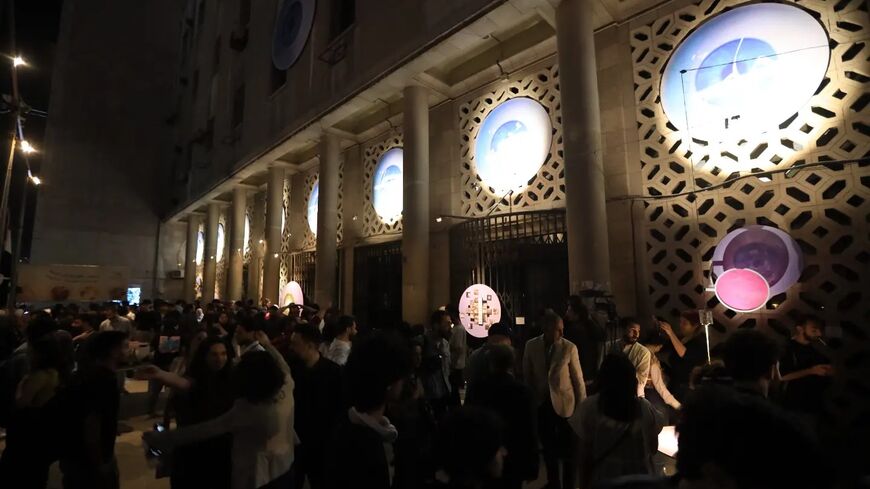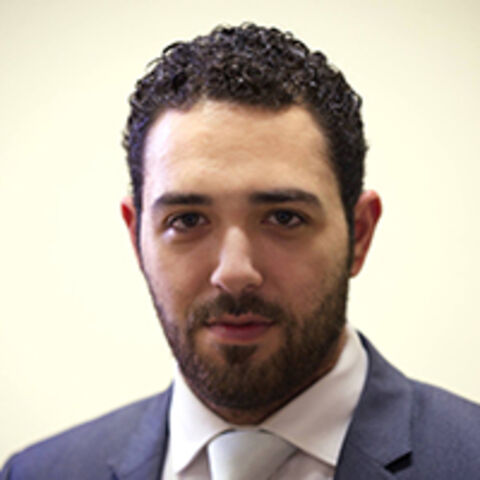DAMASCUS — Hundreds of eager Syrian art enthusiasts and bewildered passers-by alike descended on the illuminated terrace of a French colonial-era post office directory.
The crowds flocked to the building, nestled in the bustling al-Hijaz district of Damascus, to discover what the mysterious commotion was all about as the night got darker.
In the fading exterior of the building, lights revealed a multitude of written words scattered around 14 dazzlingly decorated artworks in the form of giant eyes.
The theme was the culmination of a month-long workshop by the Madad Art Foundation for visual arts, which sought to harness and improve the skills and communications practices of young, enthusiastic and emerging creative talents.
The gargantuan building — which serves as the official post center of Damascus governorate — was adorned with colors, artistic concepts and ideas for the “Written Eye” exhibition held April 20-27.
Buthayna Ali, a professor at the Faculty of Fine Arts at Damascus University and founder of the Madad Art Foundation, spent weeks painstakingly planning the display with the artists.
“The primary aim of the work is to essentially delve into the experimental forms of visual arts, to explore the deepest meanings of the word and its impact on the creative spirit of the artist and how it is manifested in his artwork, in addition to developing the notion of personal writing to reach the other more effectively,” Ali told Al-Monitor.
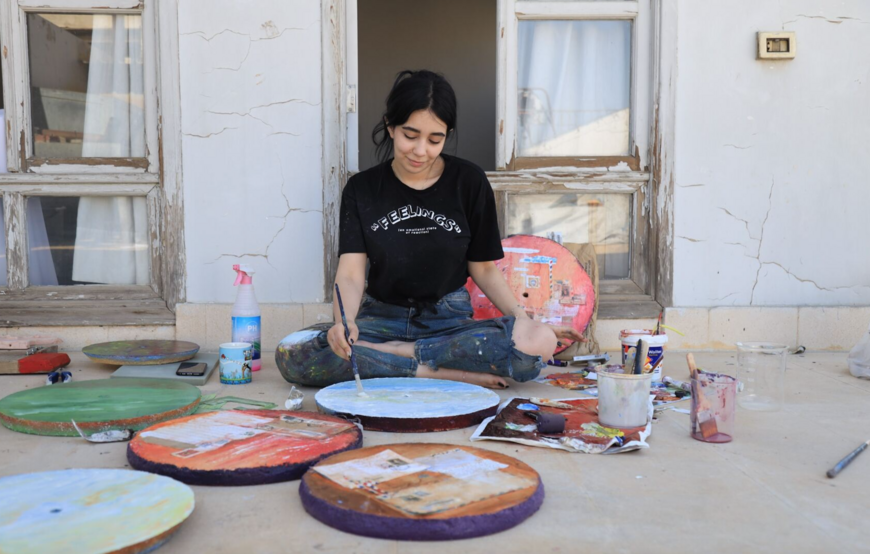
Amid the packed crowds on the congested terrace, attendees took selfies next to the pieces, interacting with the installations and admiring the artworks. The young artists were asked about their creations, further capturing the increasing appetite for art that has gripped the country.
The foundation is renowned for constantly thinking outside the box, and their exhibitions are seldom straightforward, with many of the shows, such as “Once Upon a Time Damascus” and “The Cirque,” holding full installation displays in public, often outside in the open.
“There is nothing more fulfilling than seeing art in the public sphere and letting people interact with it. At Madad, we aim to bring art into the public and the streets where we can because that is a perfect environment for it, for all people to be affected and see,” Ali added.
Syrian art makes comeback
After years of conflict, disaster and darkness, Syrian art is finally coming back into popularity, and remarkably, the war-weary streets just can't get enough.
Interior designer Nour Barakeh was one of the participating artists at the "Written Eye" exhibition. She decorated her work using an intricate movable structure containing lost old letters that were never picked up.
Called “Contemporary Memories,” her artwork displayed stamps, memorabilia and an array of personal, unclaimed notes. One of the pieces revealed that there was a person who hadn’t seen his family in 50 years.
“When I managed to get the old letters — and it took a long time with lots of specific details — there were some negative and difficult stories. I didn’t want everyone to view it that way, so I tried to keep it positive. There was a letter with a photo of a brother and his family; he was writing to his brother. The photo was taken in the 1970s,” Barakeh told Al-Monitor.
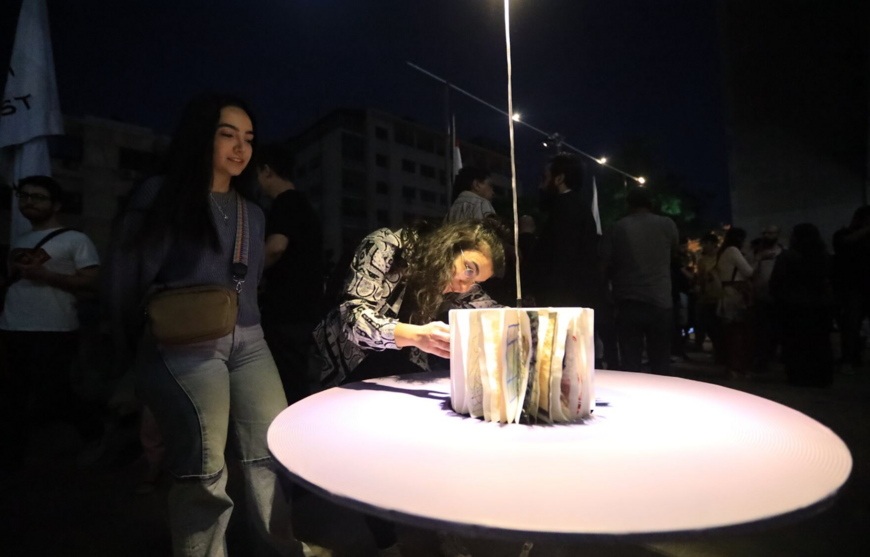
The art structure comprises a large eye featuring 15 circles of differing sizes. “The man [who wrote the letter] says that he hasn’t seen his brother in 50 years, which triggered in me a series of moving questions: What must have happened for that to happen?”
Barakeh describes her artwork as being akin to a “phoenix rising from the ashes. Tales of love and longing, exploring suspended circumstances, depict our past and present. It revives a series of memories in colors that resemble them.”
“Reverie” is an artwork by Layana al-Figaoui that depicts wings on a set of shattered glass. She avers, “We gaze, we dream, we fly, surprised that what we see is an illusion! Visions propel us toward the unknown.”
Speaking to Al-Monitor, Figaoui said, “It [the exhibition] is a new experience that gives the artist the ability to express his artwork in a written way and style. We take inspiration from what is around us and what we encounter on this journey.”
The concept of the "Written Eye," which showcases a fusion of artistry that seeks to be relevant to the everyday lives of people and artists, became a symbol with an identity when art designer Judy Chakhachirou created the logo for the exhibit, and people have been fascinated with the idea since.
“Surviving Together” is another artwork by Beesan Salhab, a 23-year-old fine arts graduate, in which she poses the question, "Can we find a way to survive together?”
Her work is meant to reflect hope, using white doves made up of blue colors and textiles to signify the idea of interfaith harmony. “This whole experience has been new for me. To do something like this is completely rare and unique; it’s a journey,” she told Al-Monitor.
Shiren Hussain’s “Not Yet!” work showed tamed forms of life emerging from an eye with a sense of tragedy. With remains slipping through its vertebrae, the eye triggers the idea is that “something happened here.”
Curious Syrians fascinated by artworks
Nourhan Hamed, 28, a theater actor who attended the event, said such rare events are exactly what the country needs. “When I learned the exhibition was there [at the postal office], I was curious to go and see what they are doing.”
“I love the concept of what they [Madad] are doing by bringing art closer to the street, which makes art become available to all the people who will pass at any hour of the day or night,” Hamed told Al-Monitor.
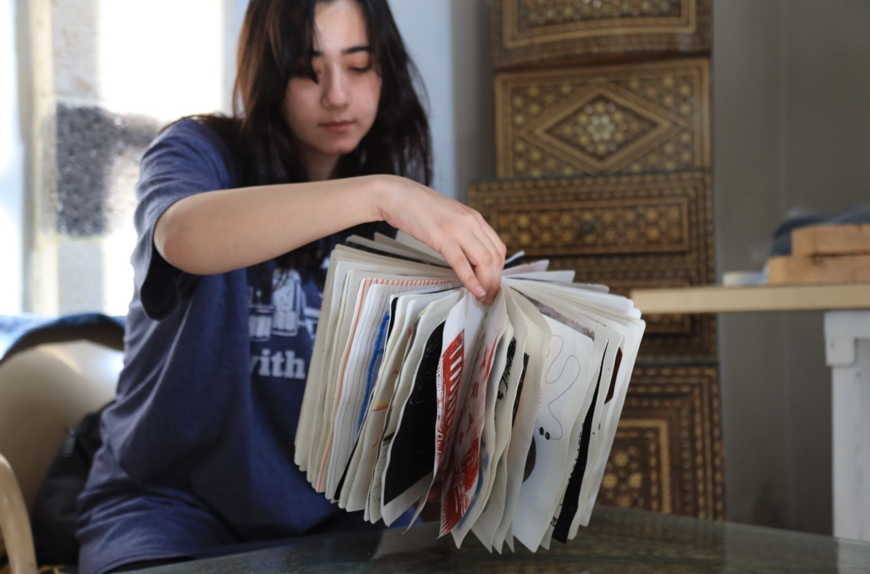
“Each artist took the concept of the eye structure and used it in his own way to express either a memory or a scene that is relatable to them. So people find different levels of relation with the different works present,” she said.
“Taking advantage of art in this way is a new form that shows us how many possibilities there are to make art and show the world ideas that they [people] think about daily but can't seem to materialize,” Hamed added.
Several of the installations had differing structures and themes. Bushra Dabaan’s “I am not Myself” features an interactive game with a card set, where audience members throws magnetic darts to land on words.
Rand al‐Mufti’s “Cross‐Roads” explores the use of time, while Rand al‐Katreeb’s “Visual Burst” shows various colors and shapes that trap us in a prison of one particular pattern.
The art scene in Syria has suffered from years of war and migration, resulting in many of the rising crop of creatives leaving the country. But such events give hope that artists in Syria can develop their skills to match their talent.
Zainab al‐Abrar Zubaida, 21, a fourth-year student of fine arts at Damascus University, told Al-Monitor, “This is just the second time that I display my artwork with Madad at a location that isn’t a gallery. This time greatly differs from the last time, because here we have a direct communication with the audience, and this exhibit isn't just a display of art.”
One gray-mustached attendee called Samer looked in awe at the exhibit: “We didn’t even know we had such talents and ideas here. I mean, this night has changed the way I see parts of Damascus. There is so much light and energy here,” he told Al-Monitor.
Artist Angela Sahwi sought to help people see through her lens with her concept dubbed “Rosy Glasses,” where each of us chooses the lens through which we view this world. While Kareem al‐Khateeb’s “The Middle Face” is a sculpture of three faces, with the one in the middle distorted in some way, Lina Hamzeh chose a message to her mother as a concept with the notion of motherhood and dreams.
For many of these youth, whose futures are yet to be written, such events provide a once-in-a-lifetime opportunity to engage in this form of artistic interaction in a country that is slowly witnessing a gradual resurrection of its creative landscape.
